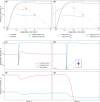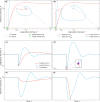Impact of different destocking strategies on the resilience of dry rangelands
- PMID: 37261319
- PMCID: PMC10227179
- DOI: 10.1002/ece3.10102
Impact of different destocking strategies on the resilience of dry rangelands
Abstract
Half of the world's livestock live in (semi-)arid regions, where a large proportion of people rely on animal husbandry for their survival. However, overgrazing can lead to land degradation and subsequent socio-economic crises. Sustainable management of dry rangeland requires suitable stocking strategies and has been the subject of intense debate in the last decades. Our goal is to understand how variations in stocking strategies affect the resilience of dry rangelands. We describe rangeland dynamics through a simple mathematical model consisting of a system of coupled differential equations. In our model, livestock density is limited only by forage availability, which is itself limited by water availability. We model processes typical of dryland vegetation as a strong Allee effect, leading to bistability between a vegetated and a degraded state, even in the absence of herbivores. We study analytically the impact of varying the stocking density and the destocking adaptivity on the resilience of the system to the effects of drought. By using dynamical systems theory, we look at how different measures of resilience are affected by variations in destocking strategies. We find that the following: (1) Increasing stocking density decreases resilience, giving rise to an expected trade-off between productivity and resilience. (2) There exists a maximal sustainable livestock density above which the system can only be degraded. This carrying capacity is common to all strategies. (3) Higher adaptivity of the destocking rate to available forage makes the system more resilient: the more adaptive a system is, the bigger the losses of vegetation it can recover from, without affecting the long-term level of productivity. The first two results emphasize the need for suitable dry rangeland management strategies, to prevent degradation resulting from the conflict between profitability and sustainability. The third point offers a theoretical suggestion for such a strategy.
Keywords: adaptive management; consumer‐resource; dry rangeland; resilience.
© 2023 The Authors. Ecology and Evolution published by John Wiley & Sons Ltd.
Figures








References
-
- Abebe, D. , Cullis, A. , Catley, A. , Aklilu, Y. , Mekonnen, G. , & Ghebrechirstos, Y. (2008). Impact of a commercial destocking relief intervention in Moyale district, Southern Ethiopia. Disasters, 32(2), 167–189. ISSN 0361‐3666. - PubMed
-
- Adriansen, H. K. (2005). Pastoral mobility: A review. Nomadic Peoples, 90(1/2), 207–214. ISSN 08227942, 17522366. http://www.jstor.org/stable/43123755
-
- Aklilu, Y. , & Wekesa, M. (2002). Drought, livestock and livelihoods: Lessons from the 1999‐2001 emergency response in the pastoral sector in Kenya. Overseas Development Institute.
-
- Baudena, M. , Giorgio Boni, L. , Ferraris, J. H. , & Provenzale, A. (2007). Vegetation response to rainfall intermittency in drylands: Results from a simple ecohydrological box model. Advances in Water Resources, 30(5), 1320–1328. 10.1016/j.advwatres.2006.11.006 - DOI
-
- Boone, R. B. , & Wang, G. (2007. ISSN 0140‐1963.). Cattle dynamics in african grazing systems under variable climates. Journal of Arid Environments, 70(3), 495–513. 10.1016/j.jaridenv.2007.02.002. https://www.sciencedirect.com/science/article/pii/S0140196307000547 - DOI
LinkOut - more resources
Full Text Sources

